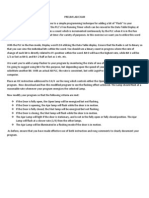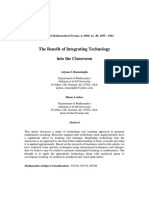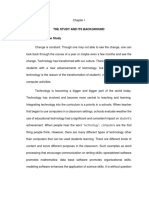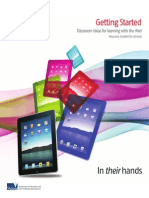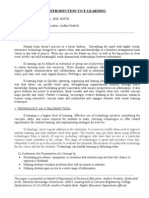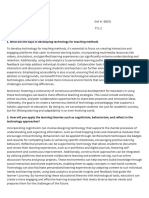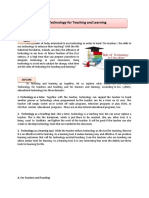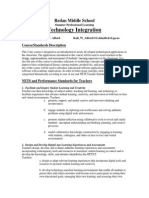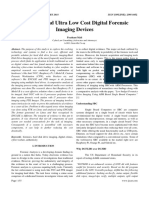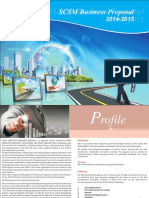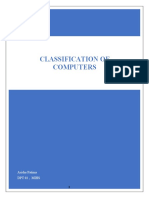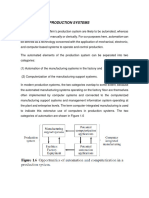Teaching and Learning With Technology Is A Reality in Many Schools
Teaching and Learning With Technology Is A Reality in Many Schools
Uploaded by
hymen11Copyright:
Available Formats
Teaching and Learning With Technology Is A Reality in Many Schools
Teaching and Learning With Technology Is A Reality in Many Schools
Uploaded by
hymen11Original Title
Copyright
Available Formats
Share this document
Did you find this document useful?
Is this content inappropriate?
Copyright:
Available Formats
Teaching and Learning With Technology Is A Reality in Many Schools
Teaching and Learning With Technology Is A Reality in Many Schools
Uploaded by
hymen11Copyright:
Available Formats
1
I. INTRODUCTION Teaching and learning with technology is a reality in many schools. It is a trend of the future and can change how students learn and how teachers teach. It reflects what many refer to as 21st century learning. Twenty-first century learning facilitates learning comprehension through access to interactive resources and mirrors what skills students will be expected to have. Laptops, and other digital devices, are helping students and teachers gain 21st century skills. One very important trend to keep in mind when thinking about cognition and educational technology is that technology itself is creating new representational tools to support thinking and problem solving. Something as simple as spreadsheet software allows for modeling data, test assumptions and running of what-if scenarios that would have been difficult if not impossible 25 years ago. More recently, technology has also provided additional representational tools such as data mining, visual representation of complex data sets and, more commonly, hypertext. These computational and technological tools can expand and strengthen human cognitive capacities.
Currently, these tools are widely available in schools and in the marketplace. Yet, relatively little is known about the cognitive demands or payoffs of educational technology usage. In order to benefit from new technology-driven representational tools, it will be necessary to gain understanding of how the tools interact with, and extend cognitive capabilities. Reviewing all the possible ways in which computer technology might have an impact on education in the early 1980s, Wujcik, (1984), realized there was a major, neglected possibility. Computers might be tools for teachers, rather than tools for teachers of students. There was little discussion then of such uses. This reflected the low value society places on teachers. Just as their pay is relatively low, little thought is given to providing teachers with tools to facilitate their work. The computers purchased for schools were and are thought of as being for the children, not for teachers. This seemed unfortunate. Teachers with access to computers as tools to facilitate their work in preparing worksheets or keeping records are more likely to appreciate the potential value of computers for their students and to think of ways in which the computer can be incorporated in their classroom teaching. Personal computers are somewhat expensive for teachers to purchase.
Technology provides an excellent avenue for student motivation, exploration, and instruction in a multisensory, diverse world. Traditional educational practices no longer provide students with all the necessary skills for economic survival in todays workplace. Embracing technology is one essential step to learning, teaching, collaborating, communicating to compete in todays world.
II. THEORETICAL FRAMEWORK The structure of this study is based on Adult Learning Theory. Speck (1996) notes that the following important points of adult learning theory should be considered when professional development activities are designed for educators: Adults will commit to learning when the goals and objectives are considered realistic and important to them. Application in the 'real world' is important and relevant to the adult learner's personal and professional needs. Adults want to be the origin of their own learning and will resist learning activities they believe are an attack on their competence. Thus, professional development needs to give
participants some control over the what, who, how, why, when, and where of their learning. Adult learners need to see that the professional development learning and their day-to-day activities are related and relevant. Adult learners need direct, concrete experiences in which they apply the learning in real work. Adult learning has ego involved. Professional development must be structured to provide support from peers and to reduce the fear of judgment during learning. Adults need to receive feedback on how they are doing and the results of their efforts. Opportunities must be built into professional development activities that allow the learner to practice the learning and receive structured, helpful feedback. Adults need to participate in small-group activities during the learning to move them beyond understanding to application, analysis, synthesis, and evaluation. Small-group activities provide an opportunity to share, reflect, and generalize their learning experiences. Adult learners come to learning with a wide range of previous experiences, knowledge, self-direction, interests, and
competencies. This diversity must be accommodated in the professional development planning.
Transfer of learning for adults is not automatic and must be
facilitated. Coaching and other kinds of follow-up support are needed to help adult learners transfer learning into daily practice so that it is sustained. The researcher espouses this theory as the central foundation of her attempt to embark on studying the extent of usage of graduate students of Arellano University. The researcher believes that the role of the classroom teacher is the crucial factor in the full development and use of technology in the schools. their technology knowledge and Teachers have to implement effectively in the
experience
classroom in order to improve student learning. III. IMPORTANCE OF THE STUDY The study may promote graduate students effective use of technology in the classroom that will inspire teachers to use technology to create new learning opportunities that will have a positive impact on student achievement. The study may pave the way for the transformation of classroom technology of Arellano University graduate students into tools for teaching and learning. This will promote exploration of the use of technology that will enable graduate
students to implement new teaching techniques to help students work collaboratively and develop higher-order thinking skills encouraging students to be engaged in the learning process The study may also provide for a way to address present problems concerning utilization, access and availability of technological
resources in the institution. IV. STATEMENT OF THE PURPOSE Specifically, it aims to: 1. What are the educational technology and materials of the university that are available for graduate students use? 2. To what extent are these educational technology equipment and materials are utilized by the graduate students? 3. What suggestions can be offered to further improve the educational technology materials and equipment and maximize their use?
V. DEFINITION OF TERMS The following terms are going to be used operationally in the study: Technology. telecommunications. Software. The programs, routines, and symbolic languages that control the functioning of the hardware and direct its operation. The use of computer software and
Digital devices. A device designed for precise measurements in scientific and engineering expressed to the smallest unit. Hypertext. A computer-based text retrieval system that enables a user to access particular locations in web pages or other electronic documents by clicking on links within specific web pages or documents. Data. Refers to groups of information that represent the qualitative or quantitative attributes of a variable or set of variables. Data Mining. The process of extracting patterns from data.
VI. REVIEW OF RELATED LITERATURE The following literatures were gathered by the researcher in support of the utilization of educational technological devices,
materials and equipments. These provided relevant guidance in the subsequent analysis of findings and drawing up of conclusions and recommendations. Professors Should Embrace Technology Because students have started using their laptops during classes, professors are making a point to restrict the use of computers during class. The main reason for this is that professors believe that instead of taking notes, students will focus more on Facebook, Twitter, or spend their time playing computer games. They say that not only will the computers distract the student whos surfing the web, but also distract other students around him or her.
Computers arent all that bad. Taking notes on a computer is actually beneficial in several ways compared to more archaic methods of note taking like paper and pen. If students were allowed to take notes on computers, they would be able to take notes faster more efficiently. We also wouldnt have to spend as much money on school supplies. If students are taking four classes theyll spend on notebooks, paper, pens, pencils and highlighters. Taking notes on computers would also help reduce the carbon footprints of students with fewer trees needing to be cut down to fill notebooks. With the growing use of technology like computers, and the emerging of new technology like iPads and e-readers, professors will soon have to accept it in the classroom, especially for note taking. If professors are willing to let technology into their classrooms, students will also have to learn to accept that, just because you have a computer in front of you, you dont have to be on Facebook. Teacher Preparation Program Norton and Sprague (2001) suggested that teachers need to be aware that using technology in teaching helps students become more engaged in their learning through collaborative efforts, simulations, and actively constructing information through new knowledge. This special education program subscribes to a constructivist approach,
working with the teachers by creating a problem-solving environment that involves using technology appropriately in their own classrooms. In integrating technology into teaching, a teacher provides students with the knowledge and skills of using the required hardware and software that can be translated across the curriculum (Grabe & Grabe, 2004). As teachers improve learning opportunities for their students with technology, they become more knowledgeable and experienced in effectively incorporating it into their teaching (Hitchcock & Stahl, 2003). Thorsen (2006) suggested that, since teachers work with diverse groups of learners, it is important to know how to design lessons incorporating technology that best facilitates their students active learning. According to Darling-Hammond et al. (2005), technology fluency is gained by exposure not only to basic skills, but also to those technology skills necessary to guide students in conducting research and data analysis, creating multimedia presentations, and participating in videoconferences with other communities of learners. When teachers see the results of effective use of technology with their students, they are more inclined to continue using technology (Male, 2003). Integrated Curriculum
10
Integration is a vital piece of teacher education because it is only when the relationships between ideas are recognized that they become meaningful (Sunal, Powell, McClelland, Rule, Rovegno, Smith, & Sunal, 2000). Otherwise, ideas become static and are not meaningful. Learning which is not meaningful is not retained. One clear objective of the elementary education program is to connect instruction/learning to real-life situations so that students learn and appreciate how different subjects are used together to solve an authentic problem (Pang & Good, 2000). In its simplest form, integration is the melding of content area concepts when real-life situations provide for such melding. However, the motive for
integrating in the teacher preparation program is not simply a sharing of the common goals of the four general content areas and their respective curricula. Rather, best practice in teacher education involves working with pre-service teachers in field-based, universitybased, and community-based settings in other words, integrating the worlds of the pre-service teacher. To be effective, teachers must not only demonstrate knowledge of how to integrate content or concepts within a particular discipline, but they must justify that this method is having a positive effect in their classroom as evidenced through student learning. Integration can only
11
be justified when students' understanding of the content is enhanced (Lonning, 1997).
VII. RESULTS AND DISCUSSIONS Table 1 Table 1. Educational Technology Equipments Available for Graduate Student Use Equipment Television DVD Player Microphone Laptop Computer Desktop Overhead Projector Printer Speaker LCD *n =28 n ( % )* 1 1 1 3 4 2 2 2 12 (3.57%) (3.57%) (3.57%) (10.71%) (14.28%) (7.14%) (7.14%) (7.14%) (42.85%) Ratio 260 students: 1 TV 260 students:1 DVD Player 260 students:1 Microphone 86 students:1 Laptop 65 students:1 Computer Desktop 130 students: 1 Overhead Projector 130 students: 1 Printer 130 students: 1 Printer 21 students : 1 LCD
Table 1 shows the distribution of frequency and percentage of the equipments, one or 3.57% of the equipments is a television, one or
12
3.57% of the equipments is a DVD player, one or 3.57% of the equipments is a microphone, three or 10.71% of the equipments are laptops, four or 14.28% of the equipments are computer desktops, two or 7.14% of the equipments are overhead projectors, two or 7.14% are printers, two or 7.14% are speakers and twelve or 42.85% are LCD projectors. Majority of the equipments are not enough for graduate students of Arellano University.
Table 2 Table 2. Educational Graduate Student Use Equipment VCD tape DVD tape CD-ROM DVD-ROM Audio-CD VHS tape Cassette Tape Map *n =2216 Technology Materials Available for
n ( % )* 506 463 774 14 66 236 28 129 (22.83%) (20.89%) (34.92%) (0.63%) (2.97%) (10.64%) (1.26%) (5.82%)
Ratio* *These materials are used by all institutes and graduate school.
13
Table 2 shows the distribution of frequency and percentage of the materials, five hundred six or 22.83% of the materials are VCD tapes, four hundred sixty three or 20.89% of the materials are DVD tapes, seven hundred seventy four or 34.92% of the materials are CDROM, fourteen or 0.63% of the materials are DVD-ROM, sixty six or 2.97% of the materials are Audio-CD, two hundred thirty six or 10.64% of the materials are VHS tapes, twenty eight or 1.26% are cassette tapes and one hundred twenty nine or 5.82%are maps and twelve or 42.85% are LCD projectors. Majority of the materials are not enough for graduate students of Arellano University. Table 3 Table 3. Extent of Utilization of Equipments and Materials Equipment Television DVD Player Microphone Laptop Computer Desktop Overhead Projector Printer Speaker LCD Projector *n =260 Materials 5 5 34 20 0 0 3 22 0 n ( % )* (1.92%) (1.92%) (0%) (13.07%) (7.69%) (0%) (0%) (1.15%) (8.46%)
14
VCD DVD CD-ROM DVD-ROM Audio-CD VHS Cassette Tape Map LCD *n =2216
No Available data
Table 3 shows the distribution of frequency and percentage of the extent of utilization of equipments and materials by graduate students of Arellano University, five or 1.92% of the graduate students utilized the television, five or 1.92% of the graduate students utilized the DVD player, thirty four or 13.07% of the graduate students utilized the laptop, twenty or 7.69% of the graduate students utilized the computer desktop, three or 1.15% of the graduate students utilized the speakers and twenty two or 8.46% of the graduate students utilized the LCD projectors. Majority of the equipments and materials are utilized by the graduate students of Arellano University.
VIII. DIRECTIONS FOR FUTURE USE
15
Professional development of graduate students for technology use should be an integral part of the school technology plan or an overall school-improvement plan, not just an add-on. Initial inclusion in the technology plan ensures that professional development is considered an essential factor in using technology to improve teaching, learning and job capabilities. Professional development for technology use should contain essential components that research has found to be important. These components include the following: a connection to student learning, hands-on technology use, variety of learning experiences, curriculumspecific applications, new roles for teachers, collegial learning, active participation of teachers, ongoing process, sufficient time, technical assistance and support, administrative support, adequate resources, continuous funding, and built-in evaluation. The ultimate goal of professional development is to improve student learning (Speck, 1996). Teachers value increased student achievement as an outcome of professional development more than any other variable and judge the value of their professional development activities by how much they see a leap in student learning," notes Lockwood (1999, p. 13). Schools should provide
16
graduate students with abundant opportunities to become fluent in using technology to bolster instruction and help students develop higher-order thinking and problem-solving skills. As a result, the use of technology enables graduate students to implement new teaching techniques and working capabilities. Recent research has shown the importance of current professional development emphasizing hands-on technology use. Professionals who received technology training in the past year are more likely than professionals who hadn't to say they feel 'better prepared' to integrate technology into their present jobs," notes Fatemi (1999). They also are more likely to use and rely on digital content for instruction, and to spend more time trying out software and searching for Web sites to use in any job related tasks." To help graduate students incorporate technology in ways that support powerful instruction requires an array of professional development experiences quite different from traditional workshops and how-to training sessions. Another important component of effective professional development of the graduate students for technology is access to on-site technical support personnel who are responsible for troubleshooting and
17
assistance after the technology and lessons are in place. When graduate students are trying to use technology in their classrooms and they encounter difficulties, they need immediate help and support. Technology that is not easily accessed and implemented will not be used. Teachers will return to more traditional ways of teaching if the problems they encounter cannot be solved quickly and efficiently. Schools, therefore, have a vested interest in providing technical support. The best way to win widespread use of new technologies is to provide just-in-time support, assistance, and encouragement when needed. Not tomorrow. Not next week. Now!" Administrators must have a clear vision of technology to support graduate students learning and an understanding of the roles that all school staff must play in achieving that vision. They must be the cheerleaders and visionaries who see beyond the daily routine to a vision of what is possible through the use of technology. Administrators also can participate in professional development activities so they are aware firsthand of how technology is used and what problems are experienced by the staff The overall technology utilization cannot occur without a significant commitment of resources by the university. The school, first of all,
18
must purchase the type of technical equipment necessary to meet the learning goals identified and provide for ongoing maintenance and upgrading. Skimping on this step can be more expensive in the long run because teachers and graduate students eventually will want and need access to multiple technologies that will enhance the curriculum and expand learning opportunities. The education technology that is implemented today must allow for increased capabilities in the future, rather than the threat of total replacement of the system. Effectiveness and efficiency uses evaluation to ensure that each activity is meeting the needs of the students and providing them with new learning experiences.
IX. BIBLIOGRAPHY
Atkinson, R.C., and Shriffin, R.M. Human memory: A proposed
system and its control processes. New York: Academic Press, 1968.
Barron, A.E. Technologies for Education: A Practical Guide, 5th Ed.,
Libraries Unlimited: Westpost, CT, 2006.
19 Cennamo, K.S., Ross, J.D., & Ertmer, P.A. Technology Integration
for Meaningful Classroom Use. Wadsworth Cengage Learning: California, USA, 2010.
Darling-Hammond, L., Banks, J., Zumwalt, K., Gomez, L., Sherin,
M., Griesdorn, J., & Finn, L. Educational goals and purposes: Developing a curricular vision for teaching. Darling-Hammond, 2006.
Grabe, M., & Grabe, C. Integrating technology for meaningful
learning. New York: Houghton Miffllin, 2004.
Hammerness, & H. Duffy (Eds.), Preparing teachers for a
changing world: What teachers should learn and be able to do. San Francisco, CA: Jossey-Bass, 2010.
Hitchock, C., & Stahl, S. Assistive technology, universal design,
universal design for learning: Improved learning opportunities. Journal of Special Educational Technology, 2003.
Male, M. Technology for inclusion. Boston: Allyn & Bacon, 2003.
Mayer, R. E. Instructional Technology: Handbook of Applied
Cognition. Chichester, England: Wiley, 1999.
Norton, P., & Sprague, D. Technology for teaching. Boston: Allyn
& Bacon, 2001.
20 O Neil, H., & Perez, R.S. Technology Application in Education: A
learning View. Lawrence Erlbaum Associates, Inc., Mahwah, NJ, 2003.
Rao, V.K. Educational Technology. A.P.H. Publishing Corporation,
New Delhi, 2004.
Reiser, R.A., & Dimsey, J.V. Trends and Issues in Instructional
Design and Technology.Pearson Education, Inc:, New Jersey, 2007.
Speck, M. Best practice in professional development for sustained
educational change. ERS Spectrum, 33-41. 1996, Spring. Thorsen, C. TechTactics technology for teachers. Boston: Pearson Education, 2006. Wujcik, A. Report to the task force on the status of technology use in schools. Washungton,DC: National Institute of Education.
You might also like
- Effects of Computer Literacy On StudentsDocument35 pagesEffects of Computer Literacy On StudentsNew Gen100% (1)
- My Personal Philosophy of Technology in EducationDocument6 pagesMy Personal Philosophy of Technology in Educationapi-302902726100% (6)
- Prelim Lab ExamDocument1 pagePrelim Lab ExamtearsomeNo ratings yet
- SOP For Software Validation - Pharmaceutical Guidelines205914Document2 pagesSOP For Software Validation - Pharmaceutical Guidelines205914Mubarak Patel67% (3)
- Grade 7 Ict ExamDocument9 pagesGrade 7 Ict ExamRoden Son100% (4)
- Roles of Technology PDFDocument34 pagesRoles of Technology PDFSage MonchelleNo ratings yet
- The Rapid Global Technological Advancement and Development of ICTDocument8 pagesThe Rapid Global Technological Advancement and Development of ICTkumar6125100% (1)
- EL 120 - Bulabos, Ma. Theresa L.Document21 pagesEL 120 - Bulabos, Ma. Theresa L.ragz autenticNo ratings yet
- Article 4Document14 pagesArticle 4api-259447040No ratings yet
- Integrated Technology PDFDocument7 pagesIntegrated Technology PDFRon Esmena100% (1)
- Final Research 1 5 3Document87 pagesFinal Research 1 5 3Charles Bognot0% (1)
- Digital Learning Inside ClassroomDocument7 pagesDigital Learning Inside ClassroomJOHN RUBIE INSIGNENo ratings yet
- TTLDocument3 pagesTTLJhelReshel CubillanTelin IINo ratings yet
- Lesson 2 - Roles of Technology For Teaching and LearningDocument6 pagesLesson 2 - Roles of Technology For Teaching and Learningrosabellaparame52No ratings yet
- ISTE National Educational Technology Standards For Students (NETSFS)Document23 pagesISTE National Educational Technology Standards For Students (NETSFS)Shairon palmaNo ratings yet
- Unit 4 - Roles of Educational TechnologyDocument8 pagesUnit 4 - Roles of Educational TechnologyAVEGAIL SALUDONo ratings yet
- Unit 6 Technology Based TeachingDocument30 pagesUnit 6 Technology Based TeachingerebarenzoeanneNo ratings yet
- Unit 4 - Roles of Educational TechnologyDocument8 pagesUnit 4 - Roles of Educational TechnologyAVEGAIL SALUDONo ratings yet
- Et347 Eportfolio MatrixDocument6 pagesEt347 Eportfolio Matrixapi-316927427No ratings yet
- Technology Integration - 1 1Document11 pagesTechnology Integration - 1 1Naveen KumarNo ratings yet
- Students' Evaluation of An Interactive Multimedia CoursewareDocument18 pagesStudents' Evaluation of An Interactive Multimedia CoursewarerommelNo ratings yet
- Lesson 3 Module - 202203140505Document5 pagesLesson 3 Module - 202203140505Precious Verlie Grace BarengNo ratings yet
- Pre-Test: What Do You Know About? DIRECTION. Answer The FollowingDocument7 pagesPre-Test: What Do You Know About? DIRECTION. Answer The FollowingMaryjoy PaladanNo ratings yet
- PED 203 Week 2Document4 pagesPED 203 Week 2Jann christiane AmbabangNo ratings yet
- TTL 1 L3 ModuleDocument6 pagesTTL 1 L3 ModuleAllyssa JhaneNo ratings yet
- Importance of Educational InnovationDocument18 pagesImportance of Educational InnovationJanice Cortez CondeNo ratings yet
- What Is Instructional TechnologyDocument3 pagesWhat Is Instructional TechnologyMousum Kabir100% (3)
- Instructional TechnologyDocument45 pagesInstructional TechnologyJancy Vincent100% (2)
- Chosen TopicDocument3 pagesChosen Topicapi-341579528No ratings yet
- The Study and Its BackgroundDocument5 pagesThe Study and Its BackgroundKerwin Santiago ZamoraNo ratings yet
- Et 247 Matrix 1Document11 pagesEt 247 Matrix 1api-316948987No ratings yet
- 2 5391116939340826650Document9 pages2 5391116939340826650marivoskanyan63No ratings yet
- Practical ResearchDocument5 pagesPractical ResearchAndrey GallardoNo ratings yet
- Ipads For Learning Getting StartedDocument41 pagesIpads For Learning Getting StartedSoraya QuirinoNo ratings yet
- E LearningDocument13 pagesE LearningnraopamuNo ratings yet
- Chapter 4 BookDocument11 pagesChapter 4 BookRose Mae S. TecsonNo ratings yet
- Technology: Positive and Negative Effects On EducationDocument9 pagesTechnology: Positive and Negative Effects On EducationJhena MarieNo ratings yet
- Module 1 - Lesson 3Document6 pagesModule 1 - Lesson 3FERNANDEZ, Julie Ann A.No ratings yet
- Ed - Tech 2 Re Ection - Enrico's CornerDocument9 pagesEd - Tech 2 Re Ection - Enrico's CornerMhelvin Baynosa LabaNo ratings yet
- Three Domains of Educational TechnologyDocument5 pagesThree Domains of Educational Technologykaren rodriguezNo ratings yet
- Tech Integration Matrix - Mobile LearningDocument5 pagesTech Integration Matrix - Mobile Learningapi-309006467No ratings yet
- EDUC5Document14 pagesEDUC5Claire Varquez BajoNo ratings yet
- DocumentDocument3 pagesDocumentLoberiano GeraldNo ratings yet
- Effectiveness of E-Learning On A Student's Pursuit in Attaining Higher Levels of EducationDocument27 pagesEffectiveness of E-Learning On A Student's Pursuit in Attaining Higher Levels of EducationNew Gen100% (1)
- Tech Integration Matrix 1Document7 pagesTech Integration Matrix 1api-307498864No ratings yet
- Impact of Computer TechnologyDocument18 pagesImpact of Computer TechnologyJay Ann Sacan DelorazoNo ratings yet
- Tech Integration Matrix FinalDocument7 pagesTech Integration Matrix Finalapi-278848083No ratings yet
- InvestorsDocument4 pagesInvestorsjoy ponoNo ratings yet
- 1 MAIN ResearchDocument11 pages1 MAIN ResearchMarc ValenzuelaNo ratings yet
- EdTEch1 Handout01Document6 pagesEdTEch1 Handout01Albert Magno Caoile100% (1)
- Lesson 3 Role of Technology in EducationDocument6 pagesLesson 3 Role of Technology in EducationJonathan100% (7)
- Marikina Polytechnic College: Republic of The Philippines Marikina CityDocument8 pagesMarikina Polytechnic College: Republic of The Philippines Marikina Citymark romel acostaNo ratings yet
- TTL Lesson 3Document5 pagesTTL Lesson 3Katlyn MRNo ratings yet
- ExamDocument3 pagesExamjoy ponoNo ratings yet
- ExaminationDocument5 pagesExaminationjoy ponoNo ratings yet
- Professional Learning 2011 Tech IntDocument5 pagesProfessional Learning 2011 Tech Intmalcolm1911No ratings yet
- ICT in LiteracyDocument6 pagesICT in LiteracySaria QasimNo ratings yet
- Revised Ch1 3Document28 pagesRevised Ch1 3Ma WenNo ratings yet
- Elearning Theories & Designs: Between Theory & Practice. a Guide for Novice Instructional DesignersFrom EverandElearning Theories & Designs: Between Theory & Practice. a Guide for Novice Instructional DesignersNo ratings yet
- Emerging Technologies for the Classroom: A Learning Sciences PerspectiveFrom EverandEmerging Technologies for the Classroom: A Learning Sciences PerspectiveNo ratings yet
- Quick Hits for Teaching with Technology: Successful Strategies by Award-Winning TeachersFrom EverandQuick Hits for Teaching with Technology: Successful Strategies by Award-Winning TeachersNo ratings yet
- INSTRUCTIONAL DESIGN AND TECHNOLOGY-BASED LEARNING STRATEGIES APPLICATIONSFrom EverandINSTRUCTIONAL DESIGN AND TECHNOLOGY-BASED LEARNING STRATEGIES APPLICATIONSNo ratings yet
- Reading Passage 3Document3 pagesReading Passage 3blindreptileNo ratings yet
- Comparative Analysis of PisoNet and PisoWifiDocument3 pagesComparative Analysis of PisoNet and PisoWifiDAVIS, KEVIN DAVE C.No ratings yet
- Fyee Ict Micro ProjectDocument15 pagesFyee Ict Micro ProjectParth AhirraoNo ratings yet
- Low Cost and Ultra Low Cost Digital Forensic Imaging DevicesDocument6 pagesLow Cost and Ultra Low Cost Digital Forensic Imaging DevicesAdv (Dr.) Prashant MaliNo ratings yet
- 20222608332322tangazo Kazi TPDCDocument18 pages20222608332322tangazo Kazi TPDCJontelli SimonNo ratings yet
- Mouse - Inside The ComputerDocument4 pagesMouse - Inside The ComputerAnival LopezNo ratings yet
- CAT P2 GR11 MEMO NOVEMBER 2022 - EnglishDocument12 pagesCAT P2 GR11 MEMO NOVEMBER 2022 - EnglishAsemahle MkivaNo ratings yet
- LS6 DLP-AE-JHS (Troubleshoot Basic Computer Software)Document6 pagesLS6 DLP-AE-JHS (Troubleshoot Basic Computer Software)Ameil EscalaNo ratings yet
- 34 Samss 846Document37 pages34 Samss 846Artur UzeevNo ratings yet
- Contact Name Position Name: Goarge Sedek Randa El SawiDocument5 pagesContact Name Position Name: Goarge Sedek Randa El Sawiabdelrahman essamNo ratings yet
- Cybercrime Prevention Act of 2012Document10 pagesCybercrime Prevention Act of 2012Raphael PangalanganNo ratings yet
- Unit IIDocument39 pagesUnit IIElora madhusmita BeheraNo ratings yet
- Quantum Computing: Source: SummaryDocument1 pageQuantum Computing: Source: SummarySandeep RathNo ratings yet
- Computer Fundamentals: Pradeep K. Sinha & Priti SinhaDocument26 pagesComputer Fundamentals: Pradeep K. Sinha & Priti SinhaSsaloni SshrivastavaNo ratings yet
- SESSION PLAN CSS NC - II UC1 - Install and Configure Computer SystemsDocument11 pagesSESSION PLAN CSS NC - II UC1 - Install and Configure Computer SystemsJunz A. Aducal100% (1)
- Retrotec US3112 US 3112 Blower Door Air Leakage Test SystemDocument21 pagesRetrotec US3112 US 3112 Blower Door Air Leakage Test SystemalinahudsonflpNo ratings yet
- First Generation: (1951 - 1958) : Vacuum Tube, Electronic Tube About The Size of DisadvantagesDocument14 pagesFirst Generation: (1951 - 1958) : Vacuum Tube, Electronic Tube About The Size of DisadvantagesFafa MavyNo ratings yet
- Sarva Business Proposal FinalDocument23 pagesSarva Business Proposal FinalSunil SethiNo ratings yet
- Mekatronik Sistemler: Prof - Dr. Fatih M. BotsalıDocument309 pagesMekatronik Sistemler: Prof - Dr. Fatih M. BotsalıCem KaçarNo ratings yet
- Tourism Information Technology: 3 EditionDocument16 pagesTourism Information Technology: 3 EditionKurniawan Gilpuy GilangNo ratings yet
- Assessing The Effect of Using Computerized Accounting Systems On Organizational Performance in ZambiaDocument72 pagesAssessing The Effect of Using Computerized Accounting Systems On Organizational Performance in ZambiaPreachNo ratings yet
- LilijenemasarumiDocument3 pagesLilijenemasarumiSajanNo ratings yet
- Classification of Computers: Arisha Fatima DPT 01, MihsDocument12 pagesClassification of Computers: Arisha Fatima DPT 01, MihsAbdullah NaeemNo ratings yet
- BSBTEC301 SESSION PLAN 1 & 2 40 Mins Each For Presentation Days ExemplarDocument7 pagesBSBTEC301 SESSION PLAN 1 & 2 40 Mins Each For Presentation Days ExemplarMuhammad TahirNo ratings yet
- S500ex Manual Version Ingles1Document16 pagesS500ex Manual Version Ingles1Jos JuanNo ratings yet
- AUTOMATION IN PRODUCTION SYSTEMS Unit 1Document12 pagesAUTOMATION IN PRODUCTION SYSTEMS Unit 1compras.seaagsNo ratings yet
- RKM Library Rules-27june2010Document9 pagesRKM Library Rules-27june2010vedvivekaNo ratings yet


